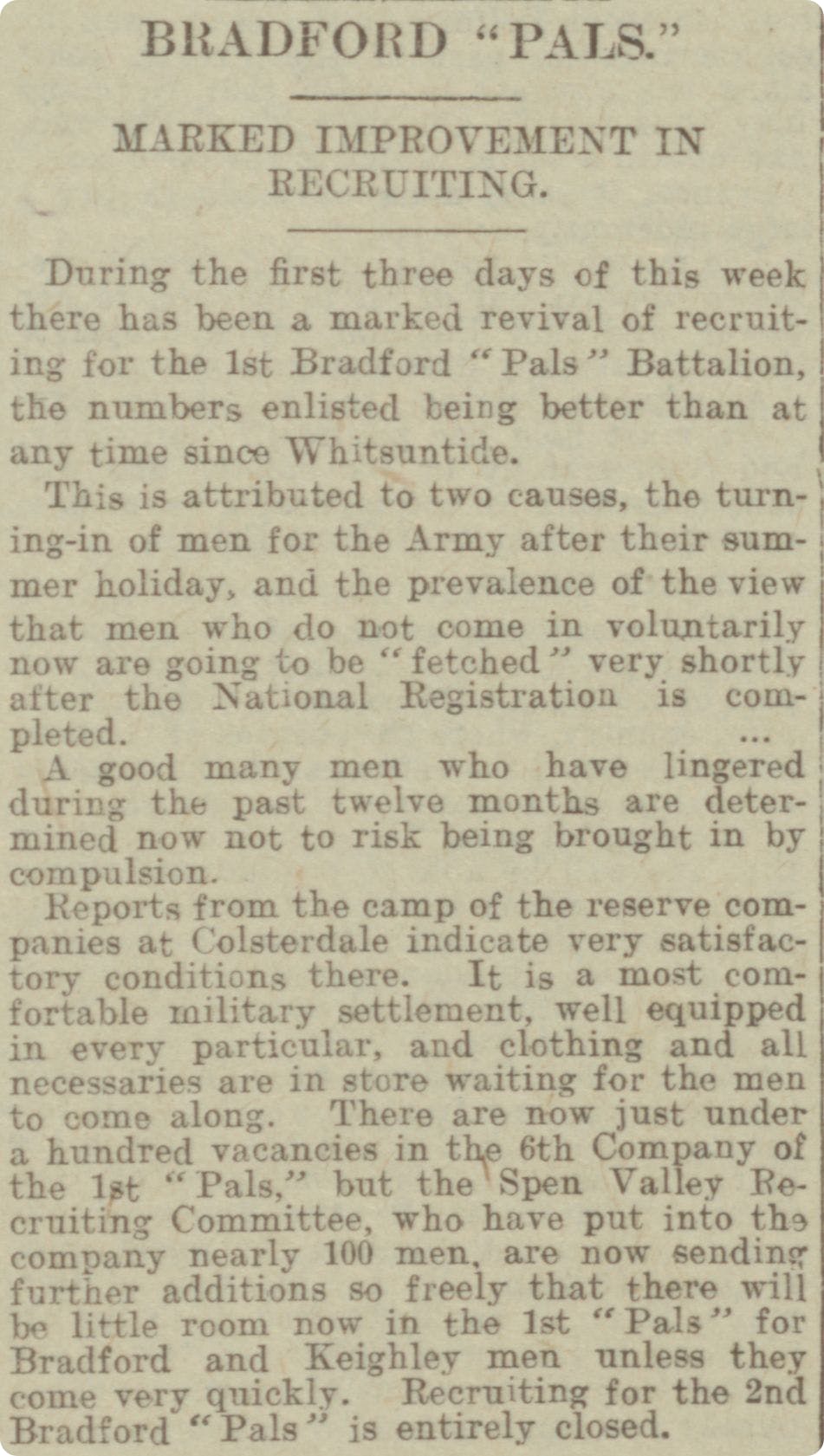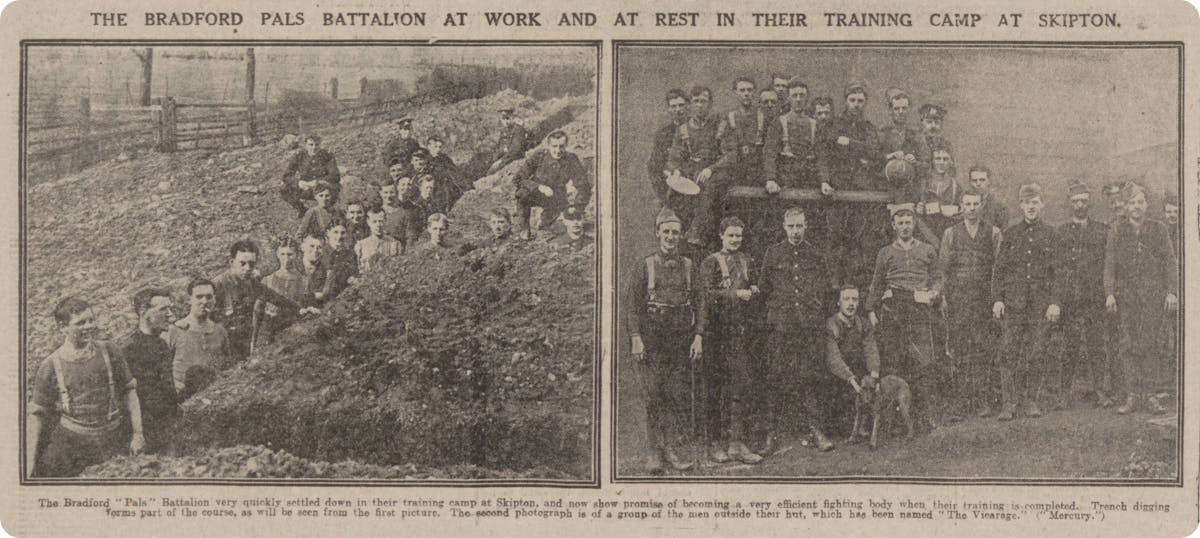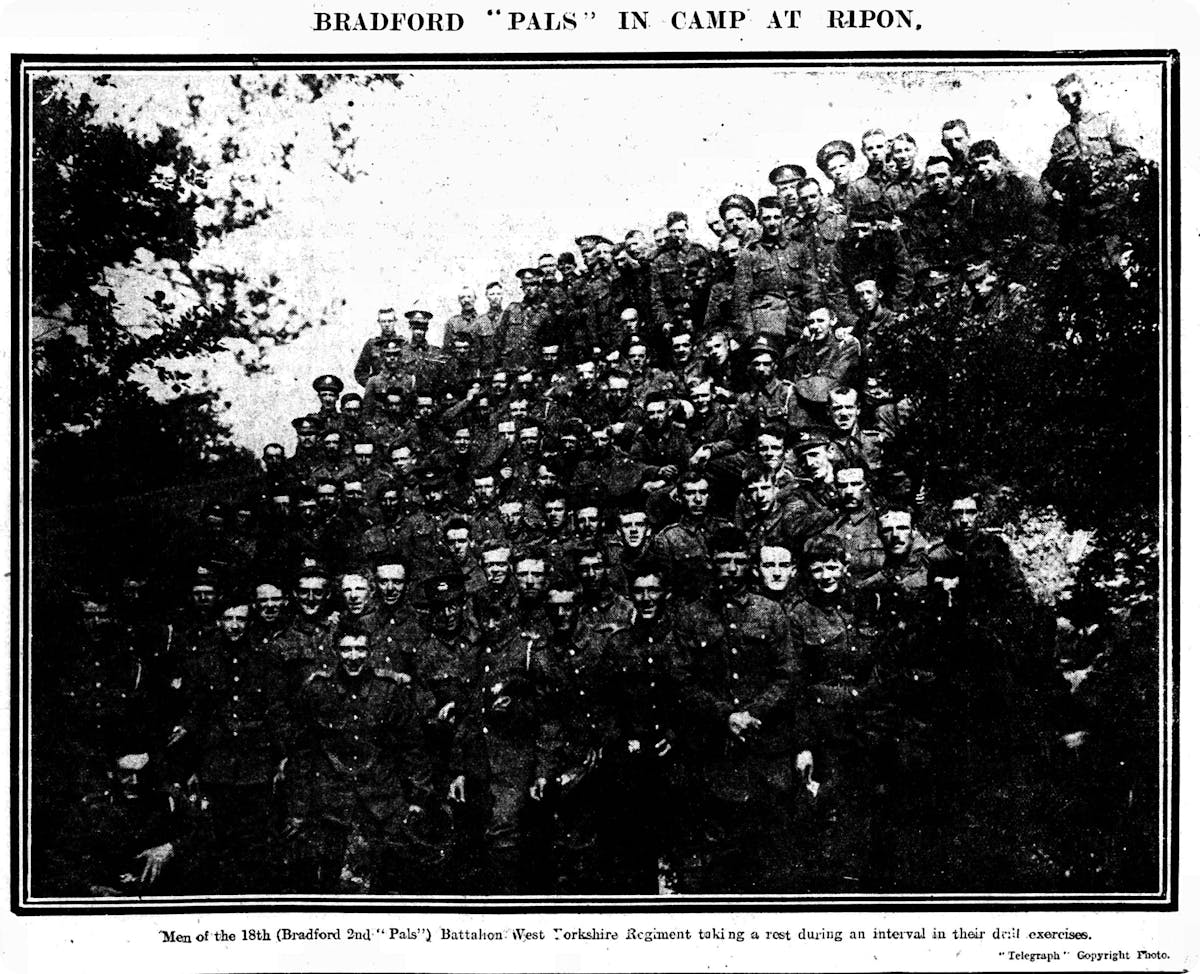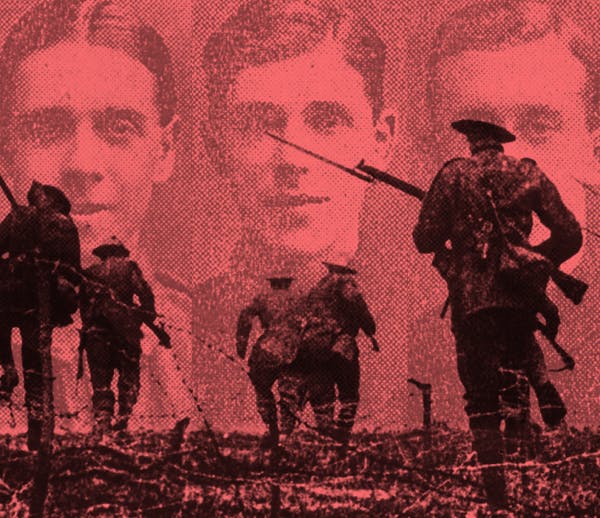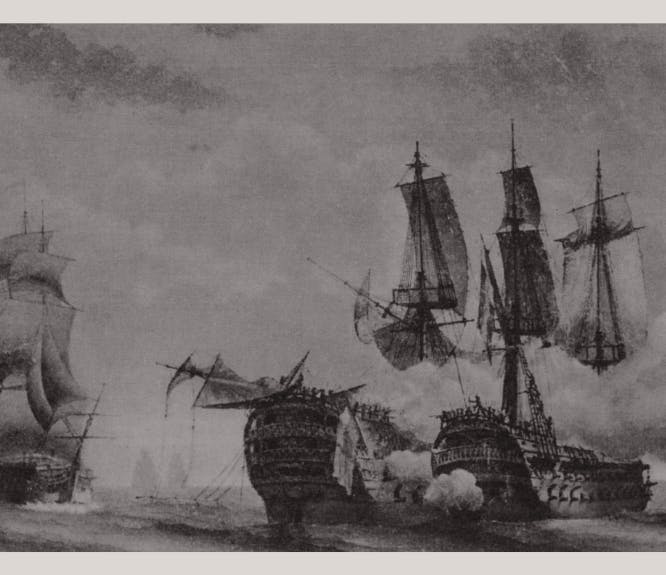Find Pals in your family
A story of sacrifice: Bradford's Pals Battalions during World War 1
8-9 minute read
By Daisy Goddard | November 6, 2025

As the threat of cannon fire loomed in the summer of 1914, the British Government devised schemes to encourage men to take up arms and fight for their country in World War 1. This is the story of Bradford's Pals Battalions.
In 1914, Britain was the only European power without a conscripted army. Manpower could sway the outcome of the war, so there was no issue more pressing than that of military recruitment. This is where Pals battalions came into play, changing the course of the war and the communities they left behind.
What were Pals battalions?
The idea came from General Sir Henry Rawlinson, who believed that men would be more likely to enlist if they could serve alongside their friends. To test this theory, he called upon London stockbrokers; within a week, over 1,600 men had enlisted, forming the 'Stockbrokers' Battalion' and providing an example for similar schemes across the nation.
The first Pals battalion was formed in Liverpool, taking its name from the Earl of Derby's directive that 'This should be a battalion of pals... [fighting] shoulder to shoulder for the honor of Britain and the credit of Liverpool'. Within two months, there were Pals battalions in more than 50 towns - including Bradford.
Did your ancestor serve with a Pals battalion?
When you trace military connections back through the years, you may just find a Pal within your family tree.
With military records and old newspaper clippings, you can help us to uncover their story, preserving their experiences for future generations. Look out for the official battalion names, the 16th and 18th Battalions of the West Yorkshire Regiment, to spot a Bradford Pal in the records.
War memorial records and medal index cards can also help pin down a Pal's story.
The story of Bradford's Pals battalions
In 1914, Bradford was a proud Yorkshire mill city, humming with the rhythm of looms. Its grand mills and smoke-stained chimneys spoke of industry and ambition, while workers poured through the streets at dawn, bound for the heart of Britain’s textile trade. Yet beneath the steady churn of machinery, there was a growing sense that the world—and Bradford’s place in it—was about to change forever.
From the earliest days of the First World War, Bradford's men volunteered to fight in the British Army, answering Lord Kitchener's call for manpower.
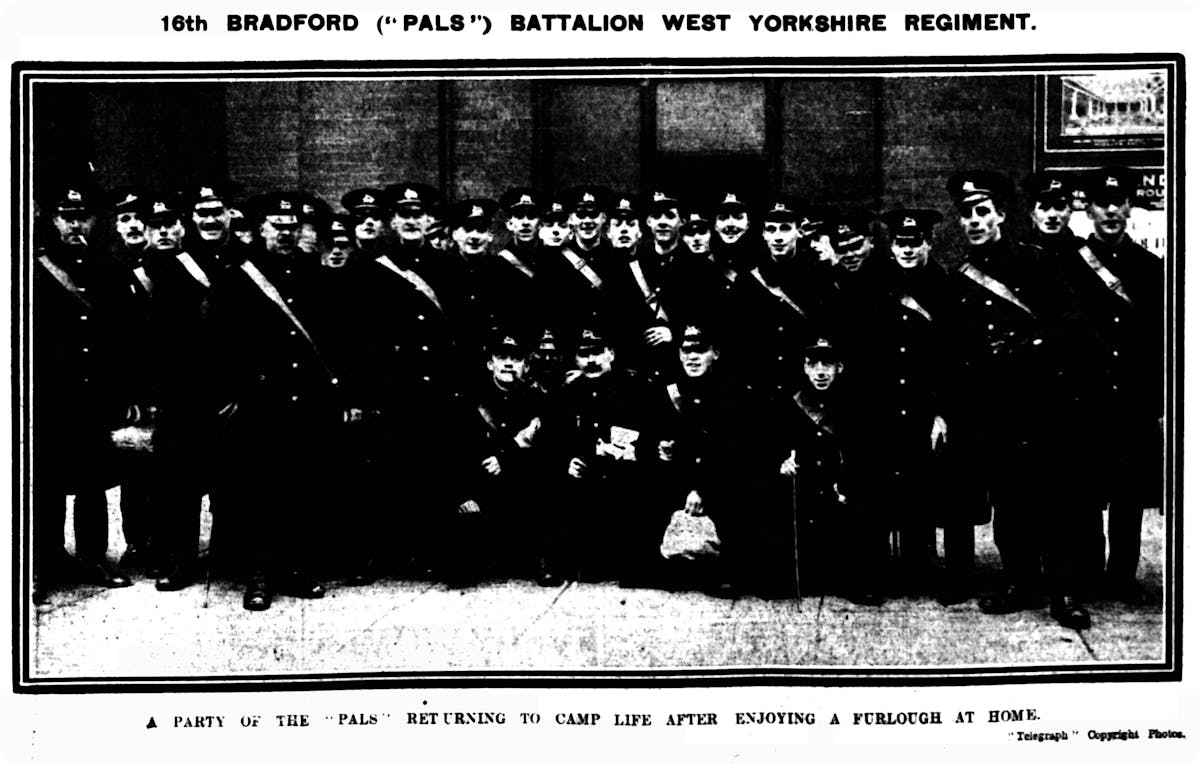
Men of the 16th Bradford Pals, pictured in the Bradford Weekly Telegraph, 5 March 1915.
Local men formed the Citizens' Army League, which later became two Pals battalions (the 16th and 18th battalions of the West Yorkshire Regiment).
Recruitment of Bradford Pals
Local newspapers paint a complex picture of the Bradford Pals recruitment process. Hundreds of men enlisted amidst the initial war fervor, with 1,000 enlisting by September 1914. They were brothers, friends, and workmates, eager to do their bit for King and country, side by side. This figure had doubled by the Spring of 1915, but ambitious recruiting targets meant that local Pals organizations had to make a concerted effort to bring in more men.
Soldiers were incentivized by medals and payments. When 195 men were needed to hit a 1,600-man target in July 1915, the Bradford Citizens' Army League offered a £5 bond to the soldier who brought in the most recruits in local recruiting drives. Many of the men who enlisted were textile factory workers or agricultural laborers, for whom £5 would've been a hefty sum.
By August 1915, the Leeds Mercury remarked upon a 'marked improvement in recruiting', attributing a recent uptick to two factors: the end of the summer holidays, and a growing suspicion that the introduction of conscription was looming. They noted that 'a good many men who have lingered during the past twelve months are determined now not to risk being brought in by compulsion'.
Training: turning men into soldiers
From January 1915 onwards, Bradford's Pals were trained in Skipton. Despite the bitter weather, conditions were noted to be 'very satisfactory'.
The Bradford Daily Telegraph noted that 'the men appear to be enjoying their new life immensely'. They were welcomed by the local community in a 'spontaneous' celebration, and soon enjoyed what Skipton had to offer, from its picture houses and library to the baths, which they were granted free access to. Life looked very different for these men now.
Their training was 'of a varied nature'. As pictured in the Leeds Mercury, it involved digging trenches, bayonet training, and countryside drills.
By February, it was observed that the Pals were 'making splendid progress'. Morale was high - 'so far there has not been the slightest sign for any slackening in the enthusiasm which was apparent on every hand when the Pals first came to camp'.
Disaster at the Somme: 'where every man was a hero'
Once their training was complete in 1915, the 16th and 18th Battalions were shipped off to France to fight. The regiment diary of the 16th West Yorkshires shows the battalion leaving 'Point 70' on 29 February 1916, sailing for Kantara and then Port Said in Egypt. By 6 March, they'd arrived in Marseille aboard HMT Minneapolis, and then travelled by train north to Mérélessart.
Some Pals units fought at the Battle of Aubers Ridge and at Ypres, but it was at the Battle of the Somme that Bradford's Pals battalions would be decimated.
Aiming to weaken German forces and gain miles of territory north of the River Somme, the Battle of the Somme would play out as one of the bloodiest battles of World War 1. Due to the regional nature of Pals Battalions, the battle would have a uniquely devastating impact on the community of Bradford.
In the summer of 1916, the 16th and 18th Battalions of the West Yorkshire Regiment were positioned near the French town of Serre, at one of the battle's most northern points.
On 1 July 1916, in the first hour of the battle, around 2,000 Bradford Pals soldiers emerged from their trenches, bravely advancing across No Man's Land. As per their instructions from above, they expected little resistance.
But tragically, this proved to be wrong.
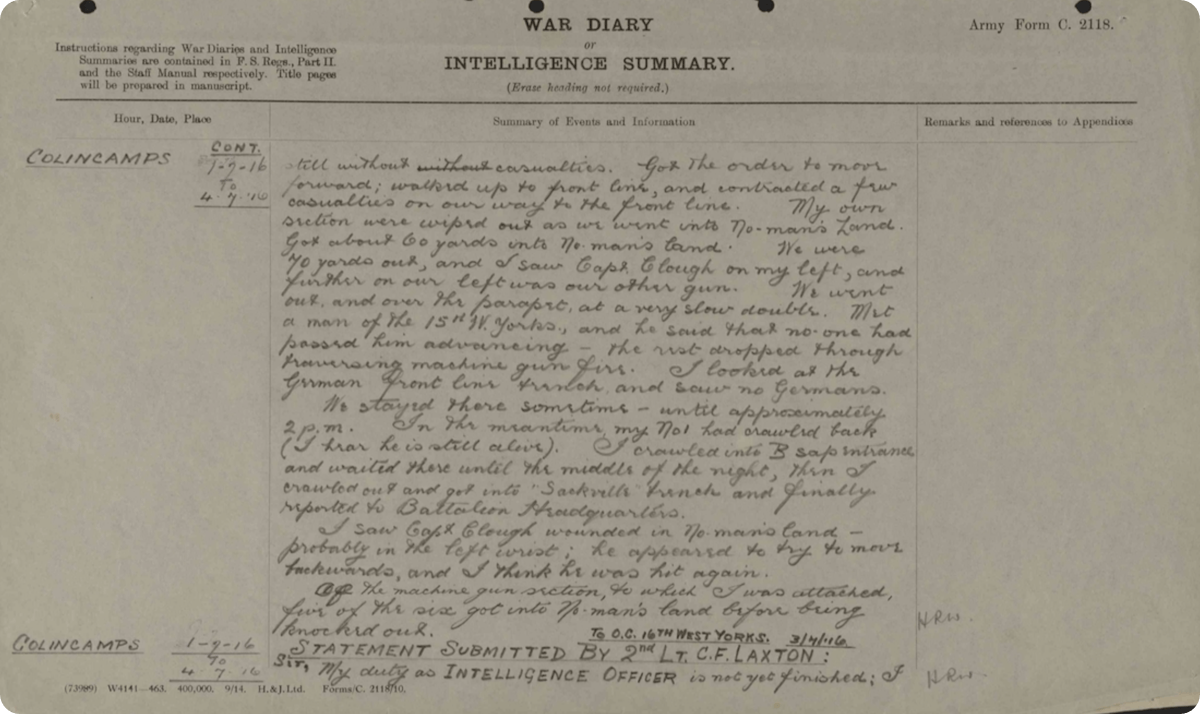
An extract from the war diary of the 16th Battalion, West Yorkshire Regiment, from 1 July 1916. WO 95/2362/1, The National Archives.
By the end of the first hour of the Battle of the Somme, 1,770 Bradford Pals had been killed or captured, and no ground had been gained. In one of the British Army's most disastrous days ever, Bradford's war heroes were wiped out in under 60 minutes.
The war diary for the 16th Battalion, written by 2nd Lieutenant C.F. Laxton, has pages of detailed entries for the first day of the Somme.
"Got the order to move forward; walked up to the front line, and contracted a few casualties on our way to the front line. My own section were wiped out as we went into No Man's Land."
On the evening of 1 July, he noted:
"I saw Captain Clough wounded in No Man's Land - probably in the left wrist; he appeared to try to move forwards, and I think he was hit again... At 5 minutes to 3, Major Guyon, Ransome and myself left our own headquarters for the front line, followed closely by our retinue. We had only been by SAP A for about two minutes when Major Guyon was struck through the helmet by a bullet. Ransome and I were alongside at the time, and bandaged him up, though unconscious and apparently dying... We urged the men on... men were falling and no-one advancing. I got about 15 yards before being hit by a bullet in the left knee... I managed to crawl into a shell hole, where I found Stead shot dead. Ransome saw me and came out to my assistance... This was the last I saw of him, but afterwards heard he was suffering from shellshock."
Major George Sutherland Guyon didn't make it. His wife gave birth to their son on 22 October that year. Lieutenant Ralph Stead was initially reported missing after the advance of 1 July - a brief glimmer of hope for his grieving family.

Casualty numbers of 1st Bradford Pals from the regiment's war diary, WO 96/2362/1, The National Archives.
The diary went on to record the casualty numbers in stark detail.
Alongside their Leeds Pals comrades, many Bradford Pals were among the 35,493 soldiers wounded on the first day of fighting. This poem, written by a wounded Pal, offers insight into life in a military hospital.
"We are proud of them, but we miss them."
As loved ones mourned fathers, sons, brothers and friends, the pages of local newspapers were flooded with photographs of the fallen local men.
Houses on every street had their curtains drawn, an inescapable reminder of the immense loss suffered by the community as a whole.
Amidst the mass mourning, the men of the 16th and 18th Battalions were remembered for their courage and sacrifice. As noted by the Bradford Daily Telegraph on 3 August 1916:
"Bradford's sons have played a gallant part in the recent fighting. Countless glorious deeds were performed on July 1st, where every man was a hero."
For Bradford's Somme survivors, fighting continued. Bradford's remaining Pals were withdrawn to Neuve Chapelle. In the winter of 1916-17, they returned to a village just a mile away from where they were on 1 July. They received the order to advance upon the German line at Rossignol Wood on 27 February 1917 - an action which would kill 66 men.

How the Bradford Pals faced the enemy, from the Bradford Weekly Telegraph, 14 July 1916.
The casualties continued into 1917, with raids at Oppy-Gavrelle, Arleux and Mericourt claiming yet more lives.
The end of the Bradford Pals
On 28 February 1918, the War Office disbanded the 16th and 18th Battalions of the West Yorkshire Regiment. Their farewell message from the Brigadier read:
"[Both these battalions] ... have loyally and devotedly upheld the splendid traditions of their Regiment, and have by their good work and efficiency, largely contributed to the high reputation of the Brigade. n times of hardship and danger, the 16th and 18th Battalions of the West Yorkshire Regiment have proved themselves brave, cheerful soldiers and good comrades... they will never be forgotten."
The last entry in the battalion's War Diary is dated 15 February 1918, stating that the battalion's strength was now nil.
There is no single roll that holds the name of every Pal. Many stories of Pals battalions remain scattered, half-remembered, or even lost. But together, we can gather them again and build the history they deserve, remembered as they once stood: side by side.
Thank you to our community members in the Findmypast Family History Forum, who suggested which Pals battalions we should explore. Now you've read the story of the Bradford Pals, you can delve deeper into the tales of the Grimsby Chums and the Liverpool Pals.

